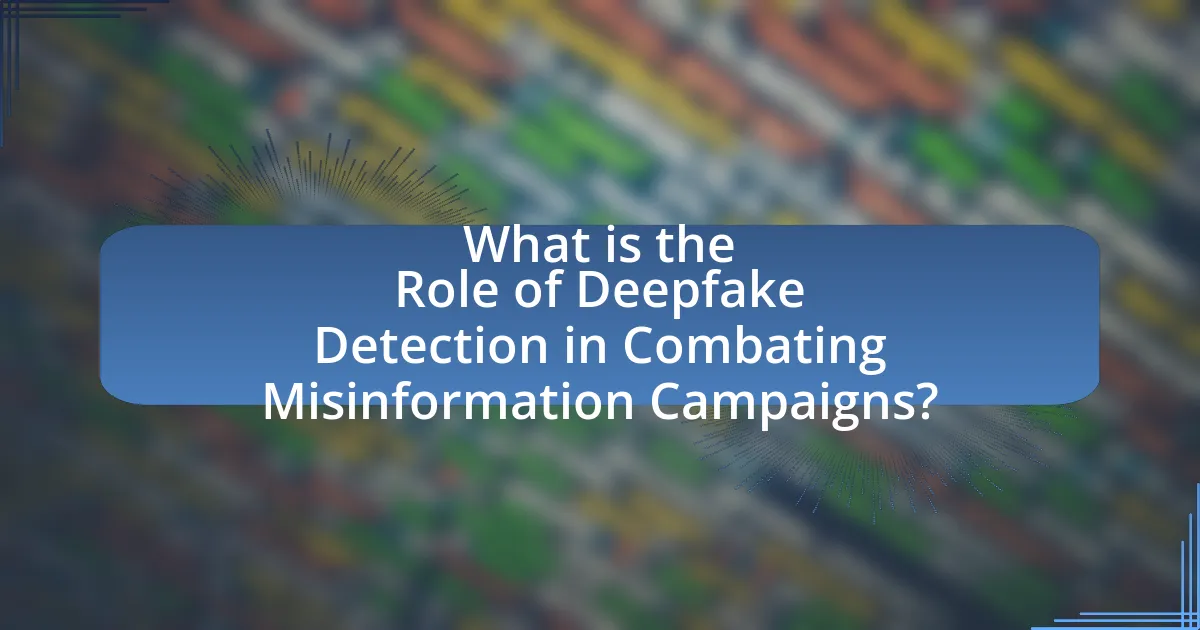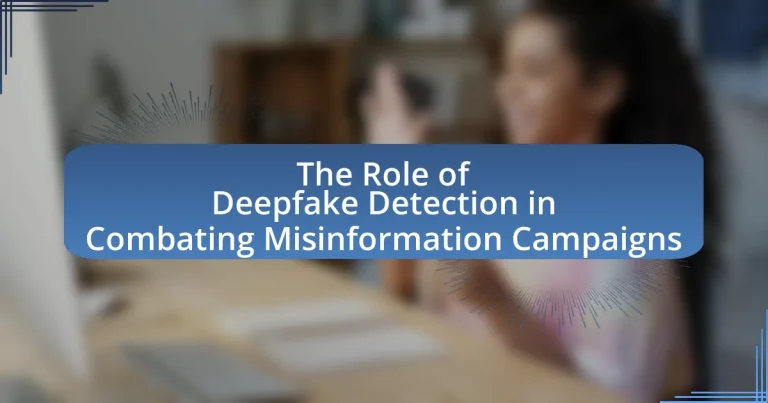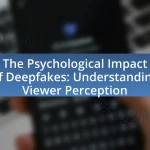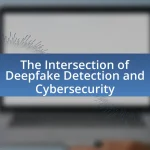Deepfake detection is a critical tool in the fight against misinformation campaigns, as it identifies and mitigates the spread of manipulated media that can distort reality. The article explores how deepfakes contribute to misinformation by creating realistic but false audio and video content, making it challenging for viewers to discern truth from fiction. It discusses the techniques used to create deepfakes, the challenges in detecting them, and the technologies employed in detection, including machine learning and forensic analysis tools. Additionally, the article highlights the importance of effective detection methods in maintaining public trust and outlines best practices for implementing detection strategies across media platforms.

What is the Role of Deepfake Detection in Combating Misinformation Campaigns?
Deepfake detection plays a crucial role in combating misinformation campaigns by identifying and mitigating the spread of manipulated media. As deepfakes can convincingly alter reality, they pose significant risks to public trust and information integrity. Studies indicate that deepfake technology can be used to create misleading videos that misrepresent individuals, leading to potential harm in political, social, and personal contexts. For instance, a report by the DeepTrust Alliance highlights that deepfakes can undermine democratic processes by spreading false narratives during elections. Therefore, effective detection methods are essential to safeguard against the manipulation of information and to maintain the credibility of media sources.
How do deepfakes contribute to misinformation campaigns?
Deepfakes contribute to misinformation campaigns by creating highly realistic but fabricated audio and video content that can mislead viewers. This technology enables the manipulation of public figures’ appearances and statements, making it difficult for audiences to discern truth from fiction. For instance, a study by the University of California, Berkeley, found that deepfake videos can significantly influence viewers’ perceptions and beliefs, with 96% of participants unable to identify manipulated content. Such capabilities amplify the spread of false narratives, eroding trust in media and institutions.
What techniques are used to create deepfakes?
Deepfakes are created using techniques such as Generative Adversarial Networks (GANs), autoencoders, and neural networks. GANs consist of two neural networks, a generator and a discriminator, that work against each other to produce realistic images or videos. Autoencoders compress and reconstruct images, allowing for the manipulation of facial features in videos. These methods have been validated through various studies, including one by Karras et al. (2019) in “A Style-Based Generator Architecture for Generative Adversarial Networks,” which demonstrates the effectiveness of GANs in generating high-quality images.
Why are deepfakes particularly effective in spreading misinformation?
Deepfakes are particularly effective in spreading misinformation because they create highly realistic and convincing audio-visual content that can easily deceive viewers. The technology behind deepfakes utilizes advanced artificial intelligence algorithms, such as generative adversarial networks (GANs), to manipulate images and sounds, making it difficult for individuals to discern the authenticity of the material. Research indicates that people are more likely to believe and share content that appears credible, and deepfakes exploit this tendency by mimicking real individuals in believable scenarios. A study published in the journal “Nature” found that 96% of participants could not accurately identify deepfake videos, highlighting their potential to mislead the public effectively.
What are the key challenges in detecting deepfakes?
The key challenges in detecting deepfakes include the rapid advancement of deepfake technology, the high quality of generated content, and the lack of standardized detection methods. As deepfake algorithms improve, they produce increasingly realistic videos that can easily deceive both automated systems and human observers. Furthermore, the absence of universally accepted benchmarks for evaluating detection tools complicates the development of effective solutions. Research indicates that detection systems often struggle with generalization across different types of deepfakes, making it difficult to maintain accuracy as new techniques emerge.
How do advancements in AI complicate deepfake detection?
Advancements in AI complicate deepfake detection by enabling the creation of increasingly sophisticated and realistic deepfakes that are harder to identify. For instance, generative adversarial networks (GANs) have improved the quality of synthetic media, making it challenging for traditional detection methods to differentiate between genuine and manipulated content. Research indicates that as AI models evolve, they can produce deepfakes that exhibit subtle nuances in facial expressions and voice modulation, which often evade detection algorithms. Consequently, the arms race between deepfake creation and detection intensifies, necessitating the development of more advanced detection techniques to keep pace with these innovations.
What limitations do current detection methods face?
Current detection methods for deepfakes face significant limitations, primarily due to their reliance on specific algorithms that may not generalize well across different types of manipulated content. For instance, many detection systems struggle with identifying deepfakes that utilize advanced techniques, such as those employing generative adversarial networks (GANs), which can produce highly realistic outputs that evade traditional detection methods. Additionally, the rapid evolution of deepfake technology outpaces the development of detection tools, leading to a persistent lag in effectiveness. Research indicates that detection accuracy can drop significantly when faced with novel deepfake techniques, highlighting the need for continuous updates and improvements in detection methodologies.
What technologies are employed in deepfake detection?
Deepfake detection employs technologies such as machine learning algorithms, computer vision techniques, and audio analysis tools. Machine learning algorithms, particularly deep learning models, analyze patterns in images and videos to identify inconsistencies that indicate manipulation. Computer vision techniques focus on detecting artifacts and anomalies in visual data, such as unnatural facial movements or mismatched lighting. Audio analysis tools examine discrepancies in voice patterns and speech synchronization, which can reveal synthetic audio. These technologies collectively enhance the ability to identify deepfakes, thereby aiding in the fight against misinformation campaigns.
How does machine learning enhance deepfake detection capabilities?
Machine learning enhances deepfake detection capabilities by enabling algorithms to analyze and identify subtle inconsistencies in video and audio data that are often imperceptible to the human eye or ear. These algorithms are trained on large datasets of both authentic and manipulated media, allowing them to learn the distinguishing features of genuine content versus deepfakes. For instance, a study published in 2020 by Korshunov and Marcel demonstrated that machine learning models could achieve over 90% accuracy in detecting deepfakes by focusing on artifacts such as unnatural facial movements and irregular lighting patterns. This high level of accuracy is crucial in combating misinformation campaigns, as it allows for rapid identification and mitigation of deceptive content.
What role do forensic analysis tools play in identifying deepfakes?
Forensic analysis tools are essential in identifying deepfakes by employing advanced algorithms to detect inconsistencies and artifacts that are often present in manipulated media. These tools analyze various aspects of digital content, such as pixel-level anomalies, audio-visual synchronization issues, and unnatural facial movements, which are indicators of deepfake technology. Research conducted by the University of California, Berkeley, demonstrates that forensic tools can achieve over 90% accuracy in distinguishing between real and fake videos by leveraging machine learning techniques to identify subtle discrepancies that human viewers may overlook.
How can deepfake detection help mitigate misinformation?
Deepfake detection can significantly mitigate misinformation by identifying and flagging manipulated media, thereby reducing the spread of false narratives. This technology analyzes video and audio content for inconsistencies that indicate alterations, such as unnatural facial movements or mismatched audio. Research from the University of California, Berkeley, demonstrates that effective deepfake detection can decrease the likelihood of individuals believing in false information by up to 70%. By providing tools that verify the authenticity of media, deepfake detection empowers users to discern credible information from deceptive content, ultimately fostering a more informed public.
What impact does effective deepfake detection have on public trust?
Effective deepfake detection significantly enhances public trust by ensuring the authenticity of information shared in digital media. When individuals can rely on the accuracy of content, they are less likely to fall victim to misinformation, which has been shown to erode trust in media sources. A study by the Pew Research Center found that 64% of Americans believe that fabricated news stories cause confusion about the facts, highlighting the importance of reliable detection methods. By mitigating the risks associated with deepfakes, effective detection fosters a more informed public, ultimately reinforcing trust in legitimate news and information sources.
How can deepfake detection tools be integrated into media platforms?
Deepfake detection tools can be integrated into media platforms by implementing real-time analysis algorithms that assess video and audio content for authenticity. These tools utilize machine learning models trained on large datasets of genuine and manipulated media to identify inconsistencies, such as unnatural facial movements or audio mismatches. For instance, platforms like Facebook and Twitter have begun using such technologies to flag potentially deceptive content before it spreads, thereby reducing the impact of misinformation campaigns. Studies have shown that early detection can significantly lower the dissemination of false information, as evidenced by a 2020 report from the MIT Media Lab, which found that misinformation spreads six times faster than factual content.
What are the best practices for implementing deepfake detection?
The best practices for implementing deepfake detection include utilizing advanced machine learning algorithms, maintaining a diverse dataset for training, and continuously updating detection models. Advanced algorithms, such as convolutional neural networks, have shown effectiveness in identifying subtle artifacts in deepfakes. A diverse dataset ensures that the models can generalize well across various types of deepfakes, as evidenced by research from the University of California, Berkeley, which highlights the importance of training on varied examples to improve accuracy. Continuous updates to detection models are crucial, as deepfake technology evolves rapidly; for instance, the detection methods that were effective in 2019 may not be sufficient today. Regularly incorporating new data and techniques helps maintain the effectiveness of detection systems against emerging threats.
How can organizations develop a robust deepfake detection strategy?
Organizations can develop a robust deepfake detection strategy by implementing a multi-layered approach that combines advanced technology, continuous training, and collaboration with experts. This strategy should include the use of machine learning algorithms specifically designed to identify inconsistencies in video and audio content, as studies have shown that such algorithms can achieve over 90% accuracy in detecting deepfakes. Additionally, organizations should invest in regular training for their staff to recognize potential deepfake content and stay updated on the latest detection techniques. Collaborating with academic institutions and technology companies can further enhance detection capabilities by sharing knowledge and resources, as evidenced by partnerships that have led to the development of more sophisticated detection tools.
What training is necessary for personnel involved in deepfake detection?
Personnel involved in deepfake detection require specialized training in digital forensics, machine learning, and media literacy. This training equips them with the skills to analyze and identify manipulated media effectively. For instance, understanding algorithms used in deepfake creation, such as generative adversarial networks (GANs), is crucial for recognizing the signs of digital manipulation. Additionally, training in ethical considerations and the societal impact of misinformation enhances their ability to address the broader implications of deepfakes. Research indicates that comprehensive training programs improve detection accuracy, as evidenced by studies showing that trained personnel can identify deepfakes with significantly higher precision compared to untrained individuals.
What future developments can we expect in deepfake detection technology?
Future developments in deepfake detection technology will likely focus on enhanced machine learning algorithms and real-time detection capabilities. Researchers are increasingly utilizing advanced neural networks, such as convolutional neural networks (CNNs) and recurrent neural networks (RNNs), to improve accuracy in identifying manipulated content. For instance, a study published in 2021 by the University of California, Berkeley, demonstrated that deep learning models could achieve over 90% accuracy in detecting deepfakes by analyzing facial movements and inconsistencies. Additionally, the integration of blockchain technology for content verification is anticipated, providing a decentralized method to authenticate media sources. These advancements aim to keep pace with the evolving sophistication of deepfake creation, thereby strengthening the tools available to combat misinformation campaigns.
How might emerging technologies improve detection accuracy?
Emerging technologies can improve detection accuracy by utilizing advanced algorithms and machine learning techniques to analyze patterns and anomalies in data. For instance, deep learning models can be trained on vast datasets of authentic and manipulated media, enabling them to identify subtle differences that may elude human detection. Research has shown that convolutional neural networks (CNNs) can achieve over 90% accuracy in distinguishing between real and deepfake videos, demonstrating the effectiveness of these technologies in enhancing detection capabilities.
What role will legislation play in the evolution of deepfake detection?
Legislation will play a crucial role in the evolution of deepfake detection by establishing legal frameworks that mandate the development and implementation of detection technologies. As deepfakes become more sophisticated and prevalent, laws can incentivize tech companies to invest in advanced detection methods, ensuring that misinformation is identified and addressed effectively. For instance, the introduction of laws like the Malicious Deep Fake Prohibition Act in the United States aims to criminalize the malicious use of deepfakes, thereby encouraging the creation of tools that can detect such content. This legal pressure can lead to increased collaboration between governments, tech companies, and researchers, fostering innovation in detection technologies and ultimately enhancing the ability to combat misinformation campaigns.
What practical steps can individuals take to recognize deepfakes?
Individuals can recognize deepfakes by critically analyzing visual and audio content for inconsistencies. They should look for unnatural facial movements, mismatched lip-syncing, and irregular lighting or shadows that do not align with the source. Additionally, verifying the source of the content through reputable news outlets or fact-checking websites can help confirm authenticity. Tools like deepfake detection software, such as Sensity AI or Deepware Scanner, can also assist in identifying manipulated media. Research indicates that deepfake detection technologies are becoming increasingly sophisticated, with studies showing that certain algorithms can achieve over 90% accuracy in identifying deepfakes.


